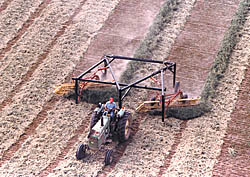
"I cut my haying time in half compared with what it took using a single wheel rake," says Kevin Kuhn, about the double rake hitch he built to pull two New Holland 9-ft. side delivery rakes.
The Oconee, Ill., farmer built the "spider hitch" from 4-in. sq. tubing. It rides on two wheels and has five vertical legs and cross bracing that makes it look like a giant spider. The unit folds to a transport width of 15 1/2 ft. Kuhn uses his 100 hp Deere 4020 tractor to pull it.
"It allows me to rake whatever width I want. I can double windrow with it, too," says Kuhn.
Both rakes are right hand delivery models, and each one is pinned to an L-shaped leg. A pair of hydraulic cylinders mount on stationary cross members at the center of the hitch. The cylinders are used to move the legs along a bar on front of the hitch, which causes the rakes to move in or out.
The hitch is equipped with a two-lever hydraulic control valve on back. One lever is used to extend or retract the cylinders. The other lever is used to operate the rakes' hydraulics.
"I built the hitch because my 4020 has only a single remote outlet, and I didn't want to tie up my dual outlet tractor. To build the hitch, I first made a working model by using 1/9th-scale toy rakes."
"The gauge marks on the cylinders indicate where the single or double rake should go. By mounting the valve on the hitch I'm able to get by with the single hydraulic outlet."
Kuhn says the hitch design allows him to minimize running his tractor wheels over the swaths. "I use the hitch to affect four swaths at a time. If I want I position the rakes to move two swaths onto two other swaths, and keep going back and forth that way until I reach the center of the field. Then I reverse the rakes and go back the other way. That way, the first windrow I raked was my wettest but by the time I get done the driest hay goes onto that same windrow. It lets me 'average out' the moisture without raking hay that's either too wet or too dry."
"In a conventional raking system if you start raking when the hay is too wet, you finish with the hay too dry. With my hitch by the time I reach the center of the field and start going back I'm throwing dry hay onto wet hay."
Another advantage, says Kuhn, is that the rakes closely follow the ground contour. "The rakes are in the same place they'd be if they were hooked to a tractor, so they follow the ground contour without gouging the ground or missing any hay," notes Kuhn.
